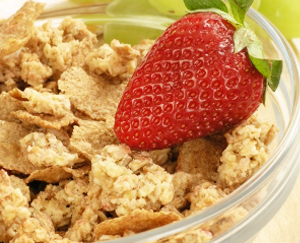Barley Fiber Improves Blood Sugar Control

Fiber is known to be one of the most important dietary factors for healthy blood sugar regulation and diabetes prevention. A study in Nutrition and Metabolism supports this, finding that a drink made with a soluble fiber derived from barley, called barley beta-glucan, improved the body’s responsiveness to insulin and improved blood sugar control in people with mildly elevated blood glucose levels.
Fifty overweight or obese adults who had high blood glucose levels but did not meet the criteria for type 2 diabetes participated in the study. They were coached in therapeutic lifestyle changes with a goal of weight maintenance, and were assigned to receive flavored drinks providing 6 grams per day of barley beta-glucan, 3 grams per day of barley beta glucan, or placebo for 12 weeks.
Barley beta-glucan better for blood sugar
At the end of the trial, the people taking the barley beta-glucan drinks appeared to have better blood sugar control and improved insulin sensitivity compared to placebo:
- Fasting insulin levels, which tell us how much insulin is circulating in the blood when the body is not responding to an after-meal blood sugar rise, decreased in the group receiving the higher dose of barley beta glucan, were approximately stable in the lower dose group, and increased in the placebo group. High fasting insulin levels are a hallmark of type 2 diabetes.
- Calculated scores used to estimate how well the body responds to insulin suggested that insulin sensitivity improved in people in the higher-dose barley beta-glucan group and stayed virtually unchanged in the lower-dose group, but worsened in the placebo group.
- Results from the oral glucose tolerance test suggested that only the barley beta-glucan drinking groups had better blood sugar control at the end of the trial.
“This study suggests barley beta-glucan may slow the deterioration of insulin sensitivity for individuals at increased risk for diabetes mellitus,” the study’s authors said.
Beta-glucan and good health
Beta-glucan is found in foods like mushrooms, oats, yeast, and barley, but the exact structure of the beta-glucan molecule depends on its source. In other words, the beta-glucan found in oats and barley is different from the beta-glucan from mushrooms and yeast, which explains why it appears to have different properties in the body.
Previous studies have shown that beta-glucan from oats, oat bran, barley, and barley bran lowers cholesterol levels. The results from the current study add to other evidence that this same beta-glucan might help people regulate their blood sugar more effectively and prevent type 2 diabetes.
The many shapes of barley
Here are some of the forms of barley you can add to your diet:
- Hulled barley. The whole, unrefined form of barley, also known as barley groats, is chewy and most nutritious. It can be used in soups or instead of rice under cooked vegetables.
- Barley grits. Grits are made from hulled barley that is toasted and cracked.
- Pot barley. Sometimes referred to as Scotch barley, this form of the grain is less refined and maintains more nutritional value than pearl barley.
- Pearl barley. This is the most commonly eaten form of barley. Pearling is achieved through polishing off the outer hull, leaving a less hearty but still fairly nutritious grain.
- Rolled barley flakes. Barley flakes maintain much of the grain’s soluble fiber. They resemble rolled oats and are usually eaten as a hot breakfast cereal.
- Barley flour. Barley contains less gluten than wheat so doesn’t always work in bread recipes. It is a good wheat flour substitute in recipes that don’t depend on yeast for rising, like quick breads and pancakes.
- Barley bran supplements. These supplements are as much as 60% beta-glucan.
(Nutr Metab 2011;8:58)
Maureen Williams, ND, completed her doctorate in naturopathic medicine at Bastyr University in Seattle and has been in private practice since 1995. With an abiding commitment to access to care, she has worked in free clinics in the US and Canada, and in rural clinics in Guatemala and Honduras where she has studied traditional herbal medicine. She currently lives and practices in Victoria, BC, and lectures and writes extensively for both professional and community audiences on topics including family nutrition, menopause, anxiety and depression, heart disease, cancer, and easing stress. Dr. Williams is a regular contributor to TraceGains Newswire.
Copyright © 2025 TraceGains, Inc. All rights reserved.
